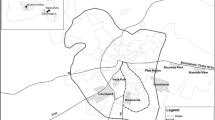Abstract
Houston was considered the premier Sunbelt city in the 1970s. Much of the growth during this boom period was fueled by the oil industry. The city led the nation in new jobs created and housing starts. The economic growth, however, was not uniformly distributed to all segments of the population-specifically, a large segment of the black community was passed over during the city’s housing boom.
Many of the housing problems facing black Houstonians can be traced to the city’s anti-public housing sentiment, policies that create and perpetuate racial segregation, and the dismantling of the fair housing enforcement mechanism. Housing discrimination, residential segregation, and other institutional barriers all limit the mobility options for a sizable segment of the black Houston community.
Similar content being viewed by others
Notes
U.S. Bureau of the Census,State and Metropolitan Area Data Book 1982 (Washington, D.C.: Government Printing Office, 1982), p. 386.
For a detailed discussion of Houston’s wards and the city’s other mostly black neighborhoods see Robert D. Bullard,Invisible Houston: The Black Experience in Boom and Bust (College Station, Texas: Texas A & M University Press, 1987); Beth A. Shelton, Nestor Rodriguez, Joe R. Feagin, Robert D. Bullard, and Robert D. Thomas,Houston: Growth and Decline in a Sunbelt Boomtown (Philadelphia: Temple University Press, 1989); Robert D. Bullard,In Search of the New South: The Black Urban Experience in the 1970s and 1980s (Tuscaloosa: University of Alabama Press, 1989), chapter 2.
Karl E. Taeuber, “Racial Residential Segregation, 28 Cities 1970-1980,” CDE Working Paper, University of Wisconsin, Madison (March 1983), p. 1.
See Larry Long and Diane De Are, “The Suburbanization of Blacks,”American Demographics 3 (September 1981), p. 20; Robert D. Bullard, “Black Housing in the Golden Buckle of the Sunbelt,”Free Inquiry 8 (November 1980), 169-172; Robert D. Bullard and Odessa L. Pierce, “Black Housing in a Southern Metropolis: Competition for Housing in a Shrinking Market,”The Black Scholar 11 (November/December 1979), 60-67.
For a thorough discussion on minority housing see Jamshid A. Momeni (ed.),Race, Ethnicity and Minority Housing in the United States (Westport, CT: Greenwood Press, 1986); also Robert D. Bullard, “Persistent Barriers in Housing Black Americans,”Journal of Applied Social Sciences 1 (Fall/Winter 1983), 19-31.
G.L. Houseman, “Access of Minorities to Suburbs,”The Urban Social Change Review 14(1981), 11–20.
W.R. Morris, “ The Black Struggle for Fair Housing: 1900-1980,”The Urban League Review 5 (Summer 1981), 6–7; Robert D. Bullard, “ The Black Family: Housing Alternatives in the 80s,”The Journal of Black Studies 14 (March 1984), 341-351.
Robert D. Bullard, “Does Section 8 Promote An Ethnic and Economic Mix?”Journal of Housing 1 (July 1978), 364–365.
Housing Authority of the City of Houston,Annual Report (Houston: Housing Authority of the City of Houston, 1984), 3.
See Robert D. Bullard,Invisible Houston, pp. 40–49; John Gilderbloom, Mark Rosentraub, and Robert D. Bullard,Designing, Locating and Financing Housing and Transportation Services for Low Income, Elderly and Disabled Persons (Houston: University of Houston Center for Policy Research, 1987), pp. 21-28; Joe R. Feagin,Free Enterprise City: Houston in Political and Economic Perspective (New Brunswick: Rutgers University Press, 1987), pp. 261–264.
Robert Aprea, Robert D. Bullard, Jeff Baloutine, and Jacqueline Alford,Allen Parkway Village/Fourth Ward Technical Report (Houston: Housing Authority of the City of Houston, 1983).
See Robert D. Bullard and Donald L. Tryman, “Competition for Decent Housing: A Focus on Housing Discrimination in a Sunbelt City,”The Journal of Ethnic Studies 1 (Winter 1980), 51–63; Franklin James, Betty L. McCummings and Eileen A. Tynan,Minorities in the Sunbelt (New Brunswick, NJ: Rutgers University Center for Urban Policy Research, 1984); and Robert D. Bullard,Invisible Houston: The Black Experience in Boom and Bust (College Station, TX: Texas A & M University Press, 1987); Robert D. Bullard, ed., “Blacks in Heavenly Houston.” Pp. 16-44 inIn Search of the New South: The Black Urban Experience in the 1970s and 1980s (Tuscaloosa, AL: University of Alabama Press, 1989).
U.S. Commission on Civil Rights,The Federal Fair Housing Enforcement Efforts (Washington, D.C.: Government Printing Office, 1979), p. 230.
See J.G. Greene and G.P. Blake,How Restrictive Rental Practices Affect Families with Children (Washington, D.C.: National Neighbors, Inc., for U.S. Department of Housing and Urban Development, 1980); Wilhelmina A. Leigh, “Barriers to Fair Hous-ing for Black Women,”Sex Roles 21 (1989), 69-84.
About this article
Cite this article
Bullard, R.D. Housing problems and prospects for blacks in Houston. Rev Black Polit Econ 19, 175–194 (1991). https://doi.org/10.1007/BF02895343
Issue Date:
DOI: https://doi.org/10.1007/BF02895343




